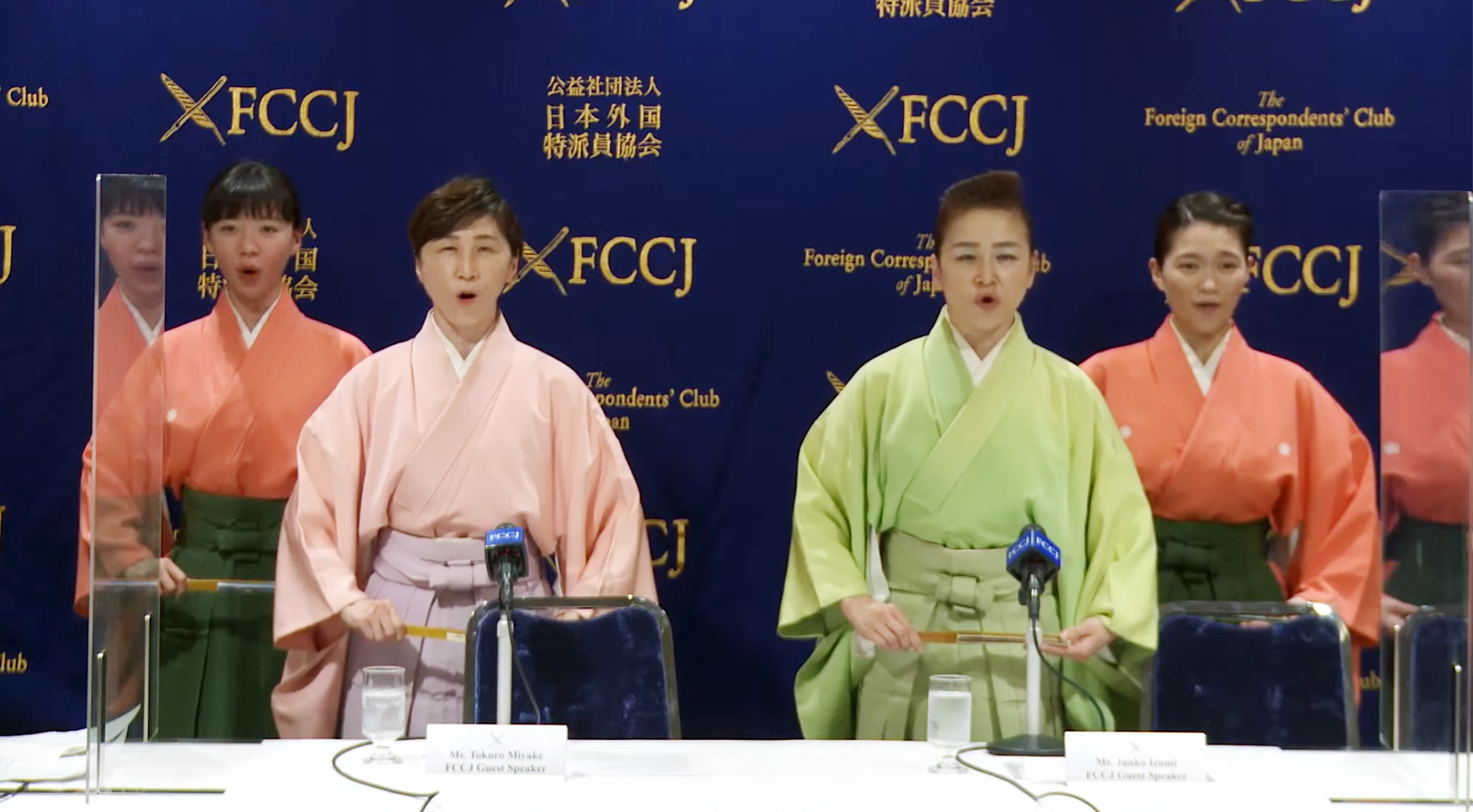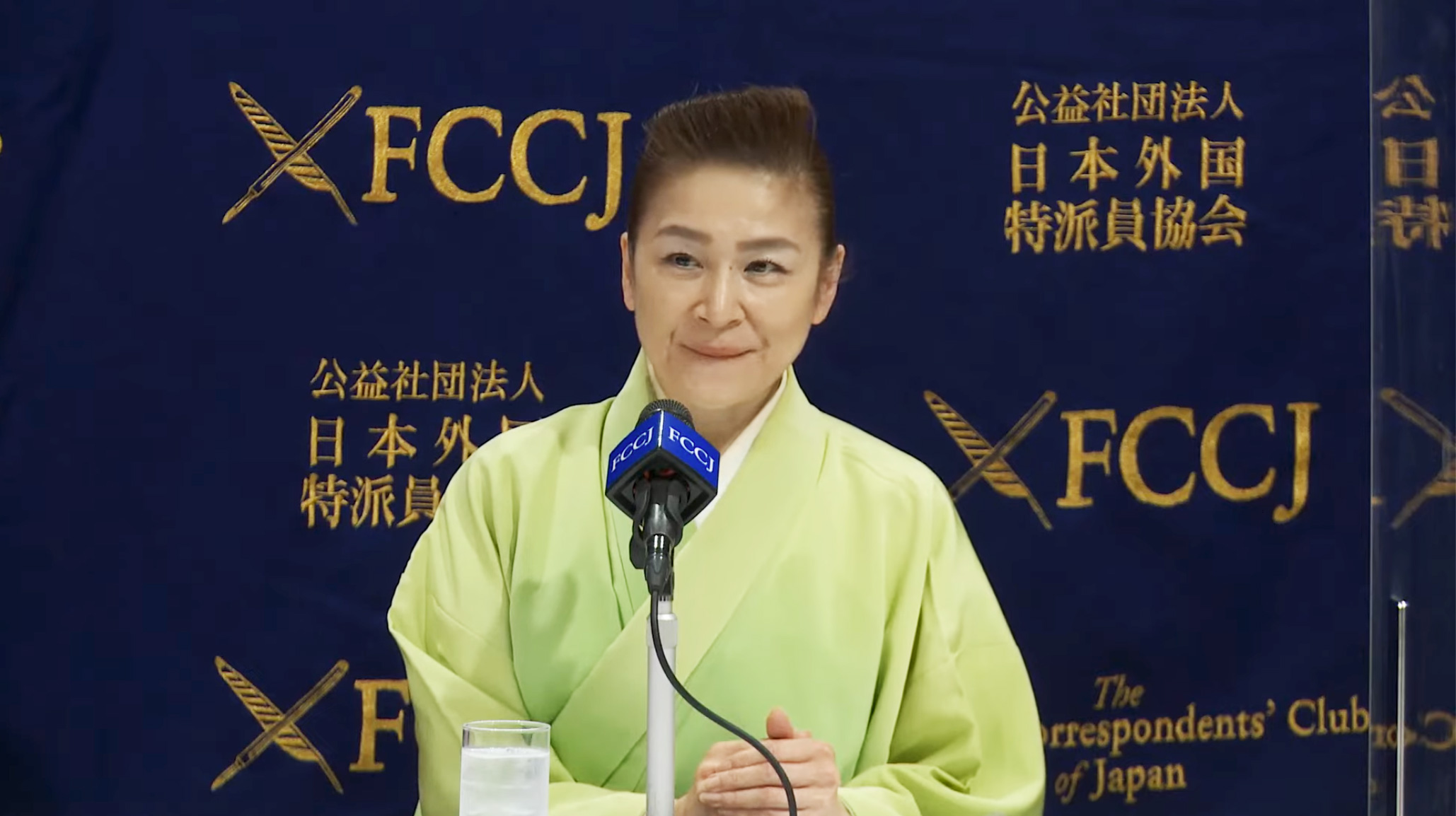Issue:
January 2023
Female actors call for gender equality in the male-dominated worlds of kyogen and noh theater

Kyogen – or “mad words” – is a traditional Japanese form of comic theater that draws on the daily lives of ordinary people. Kyogen is performed during intermissions in solemn noh plays and, with a history stretching back more than 600 years, is thought to predate its better-known cousin.
Inspired by an 11th century Japanese entertainment art called sarugaku – “monkey music” – kyogen is regarded by some as a better snapshot of Japanese society than noh due to its simplicity. Unlike noh, it features very few or no masks, the language is straightforward and, due to the use of exaggerated movements, the characters’ flaws are ruthlessly exploited but always with a dose of compassion.
However, like many Japanese traditional performing arts, both kyogen and noh have traditionally been dominated by male performers. Until recently, there have been periods in history when women were forbidden from setting foot on the “sacred” noh stage.
Junko Izumi and Tokuro Miyake the 10th are the first and the second female kyogen performers of the prestigious Izumi school. At a recent appearance at the FCCJ ahead of a special performance at the World Assembly of Women (WAW!) in Tokyo, the sisters explained why they believe that women should be allowed to flourish in noh and kyogen, two of the world’s oldest surviving forms of theater.
“Women did not appear in kyogen for more than 500 years because Japan’s history and social background had a great influence on the its development,” Izumi said of the art form, which was recognized as a UNESCO World Intangible Cultural Heritage in 2008.
Miyake said: “Traditional culture is deeply related to ethnic identity … the change in the world of traditional performing arts, which, at the first glance, has nothing to do with social issues or the economy, will lead later to a change in the traditional mindset of Japanese people.”
The most common criticism of female noh actors is that their physiques and voices are ill-suited to masculine, physically demanding roles. But female performers say objections to women performers lie in traditional notions of gender.
The Izumi school was run by Izumi and Miyake’s grandfather and later their father, Motohide Izumi – the 19th generation headmaster. The sisters began formal training before they turned 2 years old with a view to turning professional, irrespective of their gender. Their father died in 1993, aged 57.
Their mother, Setsuko Izumi, summed up the values of kyogen as “artistic, historical, and educational”, and explained how her late husband regarded his students as “human beings” first and foremost.

When the sisters turned professional at the age of 20 – as is the custom in the noh world – many of their male counterparts were neither openly supportive nor vehemently opposed to their presence in the deeply traditional world of kyogen. There was a general feeling, they recalled, that as women they would be given few opportunities to perform. Yet they proved the skeptics wrong.
Today, the Izumi school continues to be the only organization of its kind in Japan in which men and women perform on an equal footing. Now the school’s four female actors include the sisters’ nieces, Ayame Izumi and Kyoko Izumi, who appeared at the FCCJ soon after they had turned professional.
Despite training as noh actors, women were banned from the stage more than 600 years ago, and remained excluded from professional productions for a long time. Gender rights advocates have contrasted women’s relationship with noh with their more prominent role in other traditional art forms such as flower arranging and the tea ceremony, which allowed women to become professional in the early years of the Meiji period.
Looking back, it is clear that opportunities for female noh performers are a reflection of Japanese economic and social change.
Female noh enjoyed a “golden age” between 1585-1630. During the Edo period, which lasted until 1868, the Tokugawa Shogunate actively supported noh, yet women were banned from publicly performing as part of a government crackdown on “immorality”. Finally, in 1948, the Nohgaku Performers Association recognised Kimiko Tsumura as Japan’s first professional female noh actor.
The association currently has around 1,400 members, including 240 women. However, women were not recognized as intangible cultural assets until 2004 despite being as skilled as their male counterparts.
Some experts, such as the noh actor and teacher Yasunori Umekawa, have argued that instead of trying to break into the male-dominated world of noh, female performers should create a new style of noh tailored to female performers.
Japanese demographics could work in favour of female performers. Like kabuki and bunraku, noh has been suffering from a decline in students and a dip in patronage. As more young men from noh families shun the stage to pursue other careers, women have stepped in to fill the void.
Yet sheer ambition is not enough for an ordinary woman to advance in the world of noh. Becoming professional actor involves a considerable financial burden that makes breaking through near-impossible for actors who are not born into a noh family and have access to its networks, built up over generations. The bar for women in noh and kyogen remains extremely high.
References:
- Noh, by Earle Ernst; Kyogen, by P.G. O’Neill, (both from Kodansha Encyclopedia of Japan).
- From Private Zashiki to the Public Stage: Female Spaces in Early Twentieth-Century Nō by Barbara Geilhorn, Asian Theatre Journal, 2015.
- Kyōgen in the Postwar Era by Seki Kobayashi and Shinko Kagaya, Asian Theatre Journal, Spring, 2007
- A Study of Female Noh in Middle Age by Miyanishi Naoko, Nihon University, 2005
Ilgın Yorulmaz is a freelance reporter for BBC World Turkish. She is the Second Vice President of the FCCJ.

